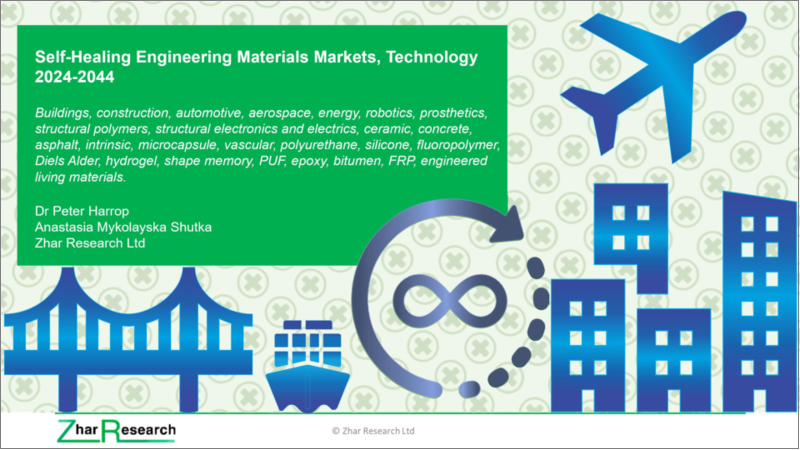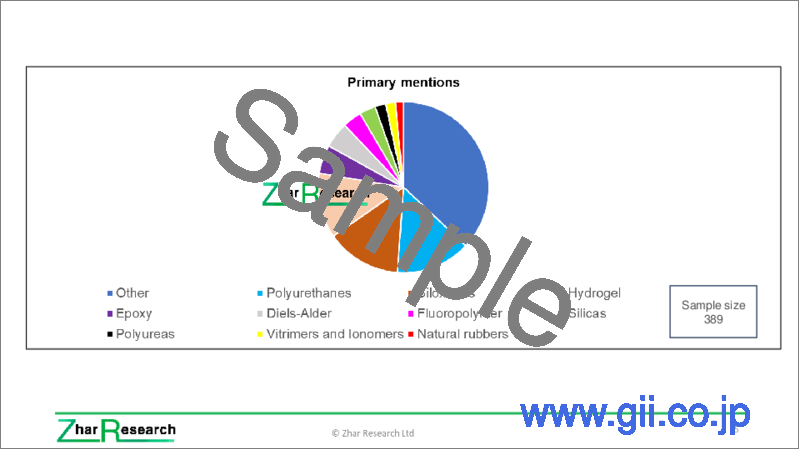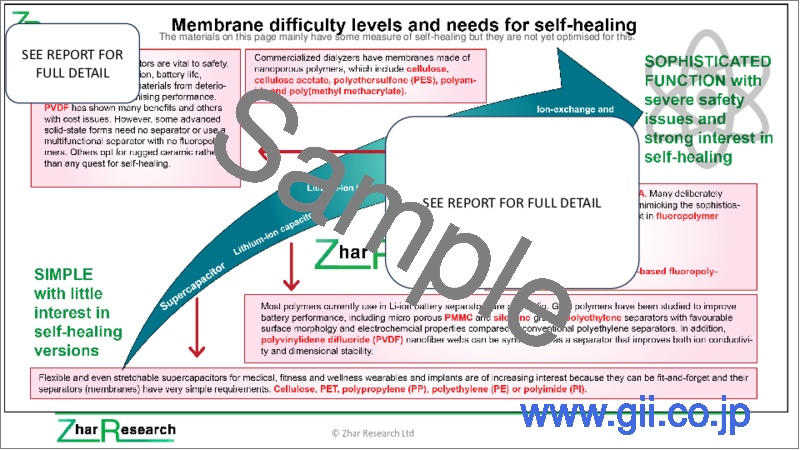|
|
市場調査レポート
商品コード
1300096
自己修復エンジニアリング材料の市場と技術:2024-2044年Self-Healing Engineering Materials, Markets, Technology 2024-2044 |
||||||
|
|||||||
| 自己修復エンジニアリング材料の市場と技術:2024-2044年 |
|
出版日: 2023年07月03日
発行: Zhar Research
ページ情報: 英文 400 Pages
納期: 即日から翌営業日
|
- 全表示
- 概要
- 目次
自己修復エンジニアリング材料は研究においても販売においても飛躍的な成長を示しています。自己修復エンジニアリング材料の市場規模は全体で21%のCAGRで推移し、2044年には1,000億米ドル超の規模に達すると予測されています。
サマリー
エンジニアリング用の自己修復材料は、調査と販売の両方で飛躍的に成長しています。そのため、このテーマに関する古いレポートは役に立たなくなります。この問題を解決するのが、 Zhar 調査 の新しい 400 ページの当レポートです。自己修復市場の 70% 以上はエンジニアリングと言えますが、残りのほとんどはヘルスケアでエンジニアリングとはまったく異なる要件であり、別のレポートの対象となっています。 Zhar 社 の予測では、市場全体が 21% のCAGRで成長し、2044 年には 1,000 億米ドルを超えると予想されています。
Zhar CEOのピーター・ハロップ博士は、「エンジニアリング用の自己修復材料市場は、継続的に更新される最新の調査を注意深く観察することによってのみ理解できるため、当レポートはこの急速に進歩する分野の最新情報だけを掲載しています」と述べています。「62社の活動の比較し、膨大な調査パイプラインに分析を加えることで、私たちは多くの詳細な結論と予測に達しました。たとえば、ポリウレタン、シロキサン、ヒドロゲルが最も広く使用され、次にエポキシ、ディールス・アルダー化合物、フッ素ポリマーが続きます。はい、これらの用語は部分的に重複していますが、文字通り、自己修復材料の構造には、マイクロカプセル、血管系、そして後に工学的生体材料 ELM の足場となる役割があります。シリカとポリ尿素は、これらに対して非常に需要があるでしょう。結論を述べますと、多くの貴社の付加価値素材のために数十億米ドル規模のビジネスが生まれるでしょう」
48ページのエグゼクティブサマリーと結論は、忙しい人には十分な情報を提供します。基本的なデータ、10の主要な結論、9のSWOT分析、 19の新しいインフォグラムと円グラフ、自己修復製品の2024年、2034年、2044年の成熟度曲線、2024年から2044年までの5つのカテゴリーの詳細なロードマップ、31行の2024年から2044年までの予測が含まれています。
第 2 章では、定義、ニーズ、自己修復指標の課題、規制、バイオミメティクスなどを含む技術動向を紹介します。これは17ページで、その後に博士レベルのZhar 調査 の解釈を含む最新の調査と意見を踏まえた自己修復ツールキットをカバーする87ページの最長の章が続きます。ここでは、内因性と外因性、自律的かどうか、そして操作、物理的、化学的、配合、形式などのオプションがあります。ナノマテリアル、物理的アプローチと化学的アプローチ、濡れたときの自己修復の重要性をご覧ください。一般的に関与する化学物質群と自己修復材料の原子ツールキットを理解します。 2024 年から 2044 年に商業化される可能性が高い用途別の重要な自己修復材料のいくつかを、ヒドロゲル、ポリウレタン、シリコーン、フッ素ポリマーなどの比較表のセクションでご覧ください。メカニズムと有望な調査ルートを多くの事例とともに解説。ここでは、ソフトロボティクス、バイオエレクトロニクス、軟骨、シリカの使用、ディールスアルダー材料、アイオノマー、超分子結合とMSA、ビトリマー、およびポリペプチドなどのタンパク質のすべてが自己修復形式であり、プロと短所。自己修復金属がなぜそれほど難しいのかを学ぶことができます。
次に、マイクロカプセルと血管系による最新の外因性自己治癒について丁寧に解説します。材質は何か?その理由は何か? 次のトレンドは何か?といった点が議論されます。 Zhar は、幾何学的なデザインと課題、工学構造における治癒剤を強化し放出する繊維、および血管のような自己修復技術を明らかにしています。この章は、最新の形状記憶支援自己修復 SMASH テクノロジー - 能力、市場、ヒドロゲル、ポリオレフィン、ポリウレタンのバージョンを含むテクノロジーの分析で終わります。傷口を閉じてから修復するオプション、繊維分散オプション、そして最後に家や耐荷重のある構造部分に利用される、成長する人工生体材料 ELM について理解します。全体を通して、新しいインフォグラムとSWOT分析が多数あります。
このツールキットを使用して、第 4 章の41ページで主要なエンジニアリング応用分野について説明します。多くの最新の調査成果が発表され、ここでは航空宇宙、陸上輸送、水上輸送、軍事、ロボット工学、さらには新しい冷却層の自己修復、セメント質材料、アスファルト、構造ポリマー、セラミックの作成などの建築や建設といった密接に関連したトピックを取り上げます。エネルギーの自己修復: 収穫、貯蔵、送電が次に続きます。これには、新しい自己修復ペロブスカイト太陽光発電や、電池や自己修復構造スーパーキャパシタの新しい自己修復固体電解質などが含まれます。最後に、情報、コンピューティング、通信 ICT が登場します。これには、6G 再構成可能なインテリジェント サーフェスや衛星通信の大規模な領域が含まれます。これらは、対象となる他の多くのものと同様に、維持と交換に莫大な費用がかかるため、自己修復する必要があります。
それで、実際には何を供給するのでしょうか? その答えは、次の章で提供されます。42ページの第 5 章「自己修復接着剤、エラストマー、コーティング、電子スキン、繊維: 2024 ~ 2044 年の見通し」、 43ページの第 6 章「自己修復膜とフィルム:第 7 章「自己修復コンクリート、構造ポリマー、セラミックス、アスファルト: 見通し 2024-2044」は52ページで構成されています。その後、レポートは23ページの第 8 章「自己修復企業の比較」で終わります。バリューチェーンと用途ごとのメーカーの割合について説明します。次に、62 社の自己修復材料の活動を比較した表があり、それぞれにコメントを含む 8 つの列があります。最後に、これらの企業のうち 12 社の自己修復活動について詳しく説明し、評価します。
Zhar レポートには、最新の事実に基づく分析、市場のギャップ、定量化された可能性、詳細な材料科学が満載です。この非常に急速に成長する新しいビジネスに利益を上げて参加するためには、不可欠なサポートが必要です。
当レポートでは、自己修復エンジニアリング材料の市場を調査し、製品・技術の概要、ニーズと課題、主要材料および用途の分析、最近の研究事例、市場規模の推移・予測、各種区分主要企業のプロファイルなどをまとめています。
目次
第1章 エグゼクティブサマリー・総論
第2章 定義・ニーズ・指標・技術動向
- 定義・代替
- 自己修復のニーズ
- 指標のジレンマ
- 技術動向
- 市場に価値を置くことの課題
- 自己修復材料に関する最近の研究:26事例
第3章 自己修復技術ツールキット
- 概要
- トップダウンの技術オプション:内部メカニズムと外部メカニズム
- 自己修復オプション:操作・物理・化学・配合・形態
- 一般的に用いられる化学族
- 自己修復材料用のアトミックツールキット
- 商業化される可能性が高い重要自己修復材料の例:用途別
- ハイドロゲルの詳細
- シリカゲル
- ディールスアルダー材・SWOT分析
- アイオノマー
- 超分子結合とMSA
- ビトリマー
- ポリペプチドなどの自己修復タンパク質
- 自己修復金属
- マイクロカプセルによる外因性自己修復・SWOT分析
- 血管系による外因性自己修復
- 血管様自己修復
- 形状記憶による自己修復SMASH
- エンジニアリング生体材料ELM
第4章 主要なエンジニアリング部門
- 航空宇宙・陸上輸送・水上輸送・軍事・ロボティクス
- 建物・建設
- エネルギーハーベスティング・蓄電・輸送
- 情報・コンピューティング・通信ICT
- その他のニーズ
第5章 接着剤・エラストマー・コーティング・塗料・電子スキンの展望
- 概要
- 接着剤
- エラストマー
- コーティング
- 人間とロボットのための電子スキン
第6章 膜・フィルムの展望
- 定義・背景
- 膜の難易度と自己修復の必要性
- 建築・音響
- 超疎水性表面
- 電池・スーパーキャパシター・燃料電池セパレーター・電解質膜
- 脱塩膜
- 濾過膜
- 腎臓透析膜
- 農業化学およびドラッグデリバリー用マイクロカプセル化膜
- ガス分離
- 車両塗装保護フィルム
- 自己監視・自己修復膜
- 水分離・防汚性超疎水性表面
- 光学およびフォトニクス
第7章 セメント・コンクリート・アスファルト・構造ポリマー・セラミックの展望
- 概要
- 産業・課題
- リーダーシップを発揮する世界の主要セメント製造業者
- HPCとUHPC
- 自己修復コンクリートとそれを可能にするセメント
- 構造用セラミック
- 繊維強化ポリマー
- アスファルト
- 構造ポリマーおよびポリマー複合材料
第8章 自己修復企業62社の比較
- 概要
- 自己修復材料製造業者62社の比較:材料・SHの例・コメント
- 12社の詳細
Summary
Self-healing materials for engineering are exponentially growing in both research and sales. That makes old reports on the subject useless. To the rescue comes the new 400-page Zhar Research report, "Self-Healing Engineering Materials, Markets, Technology 2024-2044". Over 70% of the self-healing market can be described as engineering, much of the rest being the very different requirements for healthcare - subject of a sister report. Zhar Research projections show the total market having a CAGR of 21% to reach over $100 billion in 2044.
Dr. Peter Harrop CEO of Zhar Research says, "The engineering part can only be understood by a very close look at the latest research with continuous updates so you only get the latest in this rapidly-advancing field. From comparing the activities of 62 manufacturers, the huge research pipeline and our analysis, we come to many detailed conclusions and predictions. For example, polyurethanes, siloxanes and hydrogels will be most widely employed followed by epoxies, Diels-Alder compounds and fluoropolymers. Yes, these terms partly overlap but you get the picture. There is, literally, a supporting role for structures in self-healing material - the microcapsules, vascular systems and later scaffolds for Engineered Living Materials ELM. Your silicas and polyureas will be much in demand for these. Bottom line - many billion-dollar businesses will be created for your added-value materials."
The 48-page Executive summary and conclusions is sufficient for busy people. It has basics, 10 key conclusions, 9 SWOT analyses, 19 new infograms and pie charts, maturity curves for SH products 2024, 2034, 2044, detailed roadmap for 5 categories by year 2024-2044, forecasts by year 2024-2044 in 31 lines.
Chapter 2 introduces definitions, needs, the challenge of self-healing metrics and regulation and technology trends including biomimetics and beyond. That is 17 pages which are followed by the longest chapter at 87 pages covering the self-healing toolkit in the light of latest research and opinion including PhD level Zhar Research interpretation. Here is intrinsic vs extrinsic, autonomous or not then options - operational, physical, chemical, formulation, format. See the importance of nanomaterials, physical vs chemical approaches and self-healing when wet. Understand chemical families typically involved and the atomic toolkit for self-healing materials. See some of the important self-healing materials by application likely to be commercialised 2024-2044 with sections on a comparison table, hydrogels, polyurethanes, silicones, fluoropolymers. Mechanisms and promising research routes are explained with many examples. Here are recent breakthroughs in super-strong self-healing hydrogel for soft robotics, bioelectronics, cartilage, use of silica, Diels Alder materials, ionomers, supramolecular bonding and MSA, vitrimers and proteins such as polypeptides all in self-healing form with pros and cons. Learn why self-healing metals are proving so difficult
Next comes a careful explanation of latest extrinsic self-healing by microcapsules and vascular systems. What materials? Why? What next? Zhar Research surfaces geometrical design and challenges, fibers that strengthen and emit healant in engineering structures and vascular-like self-healing. The chapter ends with analysis of latest shape memory assisted self-healing SMASH technologies - capabilities, markets, technologies including hydrogel, polyolefin and polyurethane versions. Understand close-then-heal and fiber dispersion options and finally Engineered Living Materials ELM for growing a house or a load-bearing body part. There are many new infograms and SWOT analyses throughout.
Armed with that toolkit we then address the main engineering applicational sectors in the 41 pages of Chapter 4. With many latest research achievements presented, we here cover the closely related topics of aerospace, land and water transport, military and robotics then buildings and construction including making the new cooling layers self-healing, cementitious materials, asphalt, structural polymers and ceramics . Self-healing in energy: harvesting, storage and transmission comes next including the new self-healing perovskite photovoltaics and the new self-healing solid-state electrolytes in batteries and self-healing structural supercapacitors, for example. Lastly come information, computing and telecommunications ICT including massive areas of 6G reconfigurable intelligent surfaces and satcoms that need to be self-healing because, like so many other things covered, they will be massively expensive maintain and replace. Other needs end this chapter.
So what will you actually supply? That is answered by the next chapters with 42-page Chapter 5, "Self-healing adhesives, elastomers, coatings, e-skin, fibers: prospects 2024-2044", 43-page Chapter 6, "Self-healing membranes and film: prospects 2024-2044" and 52 pages for Chapter 7, "Self-healing concrete, structural polymers, ceramics, asphalt: prospects 2024-2044". The report then ends with the 23-page Chapter 8, "Self-healing companies compared". It explains the value chain and the manufacturer percentages by application. Then comes a table comparing the activities in self-healing materials of 62 companies with eight columns for each including comments. Lastly, the self-healing activity of 12 of those companies are described and appraised in more detail.
Zhar Research report, "Self-Healing Engineering Materials, Markets, Technology 2024-2044" is full of latest facts-based analysis, gaps in the market, quantified potential and detailed materials science. It is essential support for you to profitably participate in this very rapidly growing new business.
Table of Contents
1. Executive summary and conclusions
- 1.1. Purpose and methodology of this report
- 1.2. Definitions and focus
- 1.3. Methodology of this analysis
- 1.4. Primary conclusions: Market drivers
- 1.5. Self-healing toolkit
- 1.6. Primary conclusions: materials
- 1.6.1. Eight basics
- 1.6.2. All self-healing materials SWOT
- 1.6.3. Important self-healing applications by compound commercialised 2024-2044
- 1.6.4. SWOT appraisal of polyurethanes as self-healing material
- 1.6.5. SWOT appraisal of hydrogels as self-healing material
- 1.6.6. SWOT appraisal of silicones as self-healing material
- 1.6.7. SWOT appraisal of Diels-Alder compounds as self-healing material
- 1.6.8. SWOT appraisal of fluoropolymers as self-healing material
- 1.6..9. Extrinsic self-healing by microcapsules SWOT appraisal
- 1.6.10. Vascular self-healing SWOT appraisal
- 1.6.11. Self-Healing Engineered Living Material SWOT appraisal and description
- 1.7. Difficulty and need levels for self-healing
- 1.8. Maturity curves for self-healing material technologies 2024, 2034, 2044
- 1.9. Roadmap of self-healing material for engineering by 5 categories 2024-2044
- 1.10. Market forecasts 2024-2044
- 1.10.1. Overview
- 1.10.2. Self-healing material global value market $ billion 2024-2044
- 1.10.3. Projected growth of established and new materials
- 1.10.4. Self-healing material engineering vs total value market $ billion 2024-2044
- 1.10.5. Self-healing material value market by six applicational sectors $ billion 2024-2044
- 1.10.6. Value market share for four self-healing mechanisms 2024-2044
- 1.10.7. Self-healing material value market share by region 2024-2044
- 1.11. Background forecasts: Cement, passive cooling, 6G reconfigurable intelligent surfaces
2. Definitions, needs, metrics, technology trends
- 2.1. Definitions and alternatives
- 2.2. Self-healing needs
- 2.3. The dilemma of metrics
- 2.4. Technology trends
- 2.4.1. Trend to self-healing smart materials
- 2.4.2. Engineered Living Materials come later
- 2.4.3. Biomimetics - much further to go
- 2.4.4. Overcoming the soft material dilemma
- 2.4.5. Beyond biomimetics
- 2.5. Challenges of putting a value on the market
- 2.6. 26 examples of recent research on self-healing materials
3. Self healing technology toolkit
- 3.1. Overview
- 3.2. Technology options top down - intrinsic and extrinsic mechanisms
- 3.3. Self-healing options: operational, physical, chemical, formulation, format
- 3.3.1. Physical vs chemical approaches
- 3.3.2. Three basic options for the physical structure of self-healing materials designed as such
- 3.3.3. Importance of nanomaterials
- 3.3.4. Importance of self-healing when wet
- 3.4. Chemical families typically involved
- 3.5. Atomic toolkit for self-healing materials
- 3.6. Some of the important self-healing materials by application likely to be commercialised 2024-2044
- 3.6.1. Comparison table
- 3.6.2. Hydrogel SWOT
- 3.6.3. Polyurethane SWOT
- 3.6.4. Silicone SWOT
- 3.6.5. Fluoropolymer SWOT
- 3.7. A closer look at hydrogels
- 3.7.1. Physical self-healing in hydrogels
- 3.7.2. Mechanisms and promising research routes
- 3.7.3. Super-strong self-healing hydrogel for soft robotics, bioelectronics, cartilage
- 3.8. Silica gel
- 3.9. Diels Alder materials with SWOT
- 3.9.1. Summary
- 3.9.2. SWOT appraisal of Diels-Alder self-healing materials
- 3.9.3. Diels Alder compounds including SWOT and latest research appraisal
- 3.10. Ionomers
- 3.10.1. Basics
- 3.10.2. Uses
- 3.10.3. Potential
- 3.11. Supramolecular bonding and MSA
- 3.12. Vitrimers
- 3.13. Self-healing proteins such as polypeptides
- 3.14. Self-healing metals
- 3.15. Extrinsic self-healing by microcapsules including SWOT
- 3.15.1. SWOT appraisal
- 3.15.2. Design issues and examples
- 3.15.3. Self-healing microcapsule manufacturing options
- 3.16. Extrinsic self-healing by vascular systems
- 3.16.1. Vascular self-healing SWOT appraisal
- 3.16.2. Geometrical design and challenges
- 3.16.3. Fibers that strengthen and emit healant in engineering structures
- 3.17. Vascular-like self-healing
- 3.18. Shape memory assisted self-healing SMASH
- 3.18.1. Shape memory alloys and polymers
- 3.18.2. SMASH potential markets
- 3.18.3. Hydrogel versions
- 3.18.4. Polyolefin and polyurethane versions
- 3.18.5. Close-then-heal and fiber dispersion options
- 3.19. Engineered Living Materials ELM
4. Primary engineering application sectors 2024-2044
- 4.1. Aerospace, land and water transport, military and robotics
- 4.1.1. Overview
- 4.1.2. Next big opportunities 2024-2044
- 4.1.3. Examples
- 4.1.4. US Army: smart prosthetics, ventilators, hazmat suits, soft robotics
- 4.1.5. Soft robot self-heals automatically from cuts at room temperature
- 4.1.6. Transparent, self-healing stretchable optoelectronics in robotics
- 4.1.7. Liquid Crystal Elastomer LCE robotics
- 4.2. Buildings and construction
- 4.2.1. Overview
- 4.2.2. Next big opportunities 2024-2044
- 4.2.3. Concrete issues
- 4.2.4. Ultrafast self-healing and highly transparent ice-phobic coating
- 4.3. Energy harvesting, storage and transmission
- 4.3.1. Overview
- 4.3.2. Next big opportunities 2024-2044
- 4.3.3. Self-healing perovskite photovoltaics
- 4.3.4. Self-healing materials in batteries
- 4.3.5. Self-healing supercapacitors
- 4.4. Information, computing and telecommunications ICT
- 4.4.1. Overview
- 4.4.2. Next big opportunities 2024-2044
- 4.4.3. 6G Reconfigurable Intelligent Surfaces
- 4.5. Other needs
5. Adhesives, elastomers, coatings, paint, e-skin: prospects 2024-2044
- 5.1. Overview
- 5.2. Adhesives
- 5.2.1. Basics
- 5.2.2. Epoxy
- 5.2.3. VPTA vitrimer adhesive
- 5.3. Elastomers
- 5.3.1. Basics
- 5.3.2. Analysis of leading compounds emerging
- 5.3.3. Further reading
- 5.4. Coatings
- 5.4.1. Anti-corrosion
- 5.4.2. Anti-fouling
- 5.5. Electronic skin, e-skin for humans and robots
- 5.5.1. Overview
- 5.5.2. Requirements and candidate materials
- 5.5.3. Hydrogel approach
- 5.5.4. Polyimine approach
- 5.5.5. Fluoropolymer approach
- 5.5.6. Silicone approach
- 5.5.7. PVA, polyurethane, organometallic polymer and other approaches
- 5.5.8. Appraisal of future prospects and further reading
6. Membranes and film: prospects 2024-2044
- 6.1. Definition and background
- 6.2. Membrane difficulty levels and needs for self-healing
- 6.3. Architectural and acoustic
- 6.4. Superhydrophobic Surfaces
- 6.5. Battery, supercapacitor, fuel cell separators and electrolyte membrane
- 6.6. Desalination membrane
- 6.7. Filtration membrane
- 6.8. Kidney dialysis membrane
- 6.9. Microencapsulation membrane for agro-chemistry and drug delivery
- 6.10. Gas separation
- 6.11. Vehicle paint protection film
- 6.12. Self-monitoring self-healing membranes
- 6.12. Water separation and anti-fouling superhydrophobic surfaces
- 6.13. Optical and photonic
- 6.13.1. Displays
- 6.14.2. Passive Daylight Radiative Cooling and other with SWOT
7. Cement, concrete, asphalt, structural polymer and ceramic: prospects 2024-2044
- 7.1. Overview
- 7.2. The industry and issues
- 7.3. Top cement producers in the world and which show leadership
- 7.4. HPC and UHPC
- 7.5. Self-healing concrete and its enabling cement
- 7.5.1. Basics
- 7.5.2. Intrinsic with additives
- 7.5.3. Bacteria with post treatment
- 7.5.4. Enzymes
- 7.5.5. Funghi
- 7.5.6. Natural polymers
- 79.6. Structural ceramic
- 7.6.1. Self-healing kink bands in ceramic
- 7.6.2. 3D Networks of healing activator
- 7.7. Fiber-reinforced polymers
- 7.7.1. Why so difficult
- 7.7.2. Advanced FRP now and soon
- 7.7.3. Self-healing strategies and issues
- 7.8. Asphalt
- 7.8.1. Basics
- 7.8.2. Lessons from recent work
- 7.8.3. Ongoing participants
- 7.9. Structural polymers and polymer composites
8. 62 Self-healing companies compared
- 8.1. Overview
- 8.2. Comparison of 62 self-healing material manufacturers: materials, SH examples, comment
- 8.3. Detail on 12 companies






